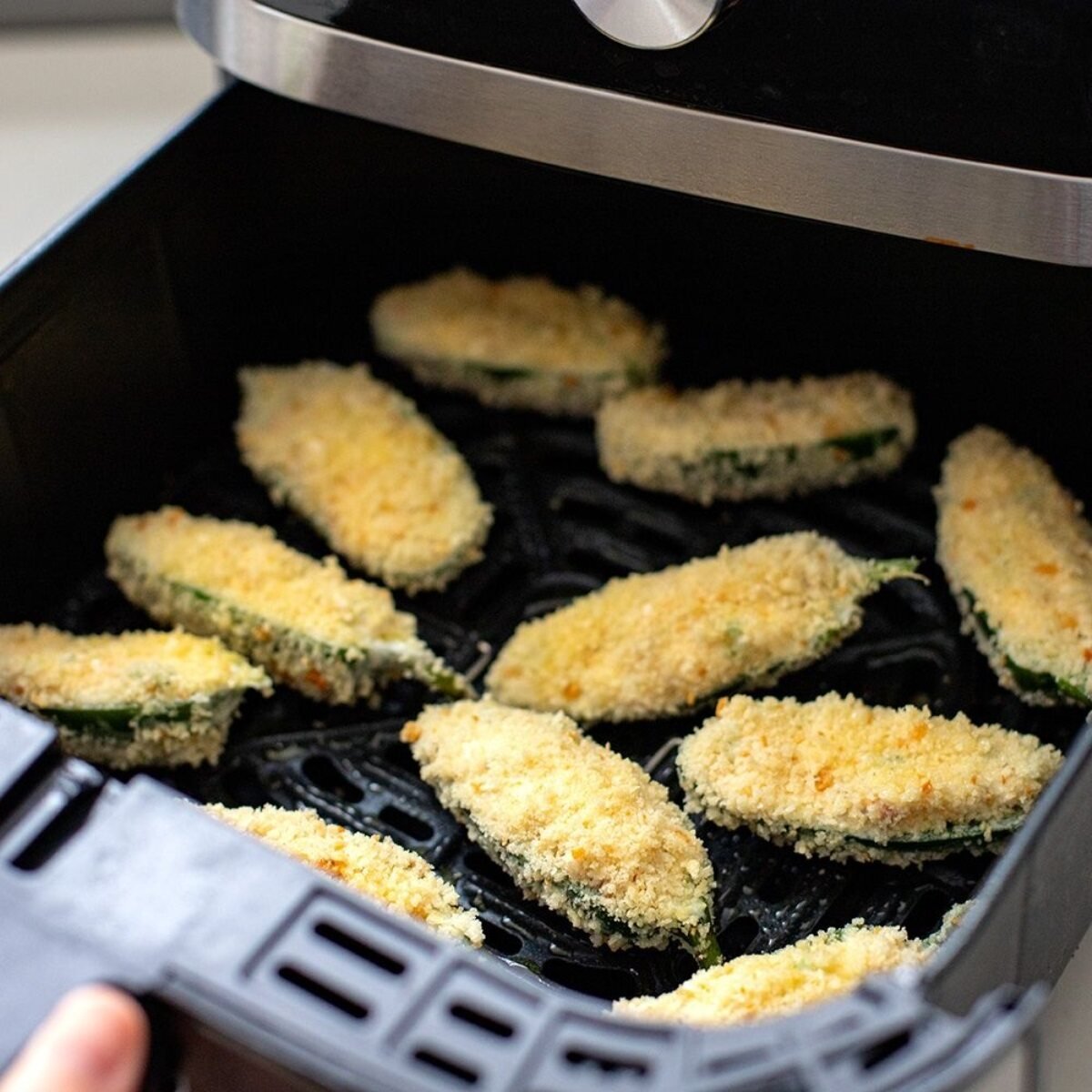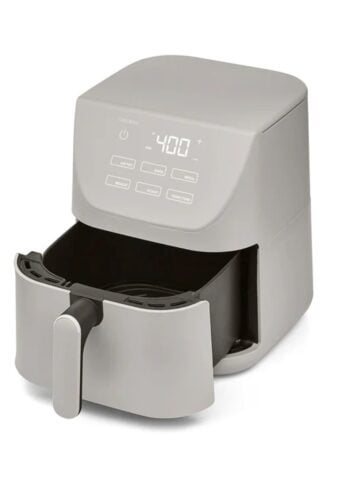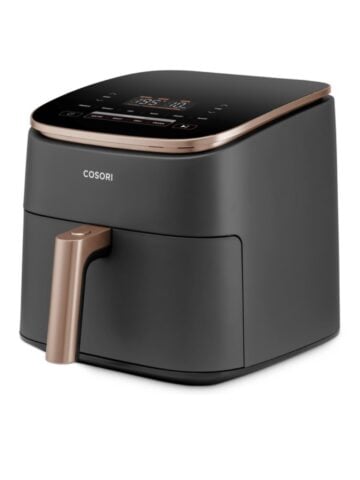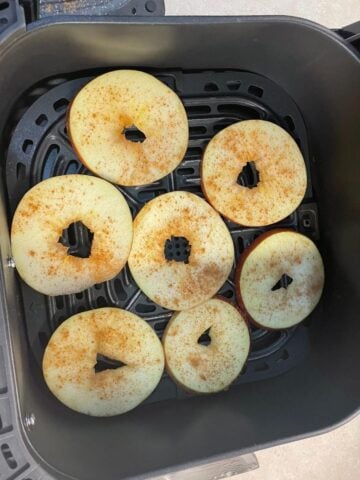
Many people are considering switching to an air fryer to help cut down on costs. With energy prices steadily rising, a common question for prospective buyers is, “How many watts does an air fryer use?”.
Although air fryers generally use less energy than conventional ovens, how much you’ll save depends on how often you use it and the appliance's size and wattage. This blog will explore the energy consumption of air fryers. We'll analyze wattage variations and examine the real impact on your monthly bills. Check it out!
Jump to:
Understanding Air Fryer Wattage and its Impact on Cooking

An air fryer's wattage essentially tells you how much electricity it needs to run. A higher wattage means more power, which usually means the air fryer heats up quicker and cooks faster. Wattages generally range from 800 watts to 2,000 watts, but a standard 4-quart air fryer consumes around 1,500 watts.
If you’re wondering how wattage impacts cooking times, consider a simple analogy: Imagine a small car versus a sports car. The sports car with its powerful engine will likely accelerate much faster.
Similarly, an air fryer with a higher wattage reaches the desired temperature quickly, leading to shorter cooking times. But if you only need a small fryer, going for lower wattage won't necessarily impact cooking. The food will still be delicious. So, how many watts does an air fryer use?
Smaller Air Fryers (800-1,200 Watts)
These compact powerhouses are great for people who live alone or couples. Perfect for whipping up small snacks or quick meals, these typically have a capacity of one or two quarts. Think about snacks like crispy fries or chicken nuggets.
However, don’t let the smaller wattage fool you. They can still be surprisingly effective, especially for smaller portions and single servings. They also tend to be the most affordable, making them an enticing choice for budget-conscious cooks.
However, because they have less capacity and power, if you routinely prepare meals for more people, you might find their small size a tad limiting.
Related: What Is The Best Air Fryer For One Person In 2024?
Mid-Sized Air Fryers (1,200-1,500 Watts)
The Goldilocks of air fryers, these mid-sized appliances balance power and size well. Typically falling within a 3-5 quart capacity range, such as the Ninja AF101 Air Fryer, can cook for about 3-4 people without breaking a sweat.
This makes them a great option for families or frequent entertainers. Their power and energy consumption is often sufficient to ensure even cooking for larger quantities and a wider variety of dishes, from succulent salmon to juicy chicken breasts.
Larger Air Fryers (1,500-2,000 Watts)
Big appetites require big fryers. These giants come with a 6-quart (or more) capacity, suitable for large families or hosting gatherings. Take the Instant Vortex Slim XL for example. It might surprise you that despite the size and higher wattage, they don’t necessarily skyrocket your electricity bills with energy consumption.
Although large fryers can be helpful for families who frequently prepare multiple dishes or want the flexibility to cook larger batches, remember that these come at a higher cost and may take up more kitchen space.
Some large models even need dedicated power outlets, so if your home has older wiring, you may want to consult with an electrician first.
Also read: Farberware Air Fryer: How To Use Guide
Breaking Down Air Fryer Costs: Wattage, Usage, and Your Monthly Bill

Calculating an air fryer’s energy cost isn't straightforward because multiple factors contribute to energy consumption. The manufacturer’s stated wattage indicates maximum consumption while the device runs.
Many air fryers have multiple power settings that don’t require the device to operate at full blast. Plus, variables like cooking temperature, food quantity, the frequency you use it, and even the fryer’s efficiency affect your final bill.
Think of it like your car’s fuel efficiency - factors like speed, road conditions, and engine size all contribute to your final fuel usage.
Luckily, there are a few online resources and formulas that can help demystify these costs. The first step is figuring out how much electricity the appliance consumes per day. Jennifer Warren of Energy Guide recommends a simple calculation.
Simply grab the power rating in kilowatts (found on your fryer), multiply it by the average hours used per day, and then divide by 1,000 to get the daily kilowatt-hour (kWh) consumption. This might sound technical, so let’s use a practical example. If you’ve got a 1,500-watt air fryer you use for an hour daily:
- First, convert the wattage to kilowatts (1500/1000 = 1.5kW)
- Multiply that by your daily usage in hours (1.5 kW * 1 hour = 1.5kWh)
Now that you have your kWh consumption, it’s time to figure out the cost. The price you pay per kWh varies depending on where you live and the rate your electricity provider charges. You can usually find this on your monthly bill.
As of January 2023, electricity costs in the UK were around 34 pence per unit. But this can vary widely, so double-check with your specific provider. If your rate was 34 pence per kWh, your air fryer (in the example above) would cost 51 pence to run daily or about £1.78 weekly (£7.65 monthly).
Air Fryer Use Cost Versus Traditional Oven
Air fryers, in general, are a much cheaper and more efficient alternative to a traditional oven, but if you are really concerned about those energy costs, remember that even air fryer models vary in their consumption. The smaller, compact ones use the least, while the behemoths require the most.
The same applies to ovens—a powerful built-in oven designed for a large family will use significantly more energy than a basic countertop model. Studies suggest that an average air fryer, at 1,500 watts, used for 30 minutes, will consume roughly 0.75 kWh, making it generally a lot less expensive than using your full-sized oven for the same amount of time.
Also read: Gourmia vs Power XL Air Fryer: Which Cooks Best?
Do Air Fryers Actually Help Lower Electricity Costs?

Yes, for many reasons. They consume less electricity because they’re smaller. Unlike ovens, air fryers are specifically for small batches or single meals, so you're heating a smaller chamber.
They also reach a peak cooking temperature more rapidly than an oven. The average oven loses half of its heat each time you open it. Since most air fryers have a sealed basket and are quicker to cook, less energy escapes, contributing to a smaller electric bill overall.
Also, let's not forget those extended oven preheat times. Even the most basic models heat up pretty quickly, further shaving those precious kilowatt-hours off your consumption.
To figure out the amount of electricity your specific air fryer might use, you can use a simple electricity usage calculator. They are also much less expensive to run than other small kitchen appliances.
Compared to running your oven for an hour, air frying typically consumes about ⅓ to ½ less energy for cooking the same item.
This means that the monthly cost of operating an air fryer works out significantly less than what your traditional methods of cooking will cost you. Sounds great, right?
Related: How To Preheat Air Fryer: Simple Steps & Guide
Making Smarter Energy Choices for Your Air Fryer

So you’re on board with saving money with your air fryers energy usage, that's great. Here are a few practical tips to squeeze the most efficiency out of your appliance:
- Consider the Size. Picking the right-sized fryer is crucial. A big one might be tempting but it'll draw more power. Match it to the portions you usually cook.
- Use those Presets. Many modern fryers come with pre-programmed settings for common foods. These aren't just for convenience; they're optimized for time and energy use.
- Preheat Smartly. Most air fryers don't require preheating for long. It'll add unnecessary time and bump up those kilowatt-hours.
- Fill it Right. While you want to avoid overcrowding the basket (which blocks air circulation) when you air fry, cooking tiny portions in a large air fryer wastes energy.
- Know When Not to Fry. While we love them, air fryers aren’t best for everything. Don't force foods into it. If your dish calls for something better suited for an oven or stovetop, use those.
Even though we often focus on wattage and kilowatts, remember that energy efficiency isn’t just about the number on the label. It’s about being a bit smarter. Make small adjustments and pick a good model.
It can go a long way toward saving on your energy bills, especially in an era where energy conservation is top of mind. And it’ll make those delicious air-fried goodies feel even tastier.
FAQs
No, air fryers don't typically use a ton of electricity and max out electricity bills. On average, they use about 1.5 kilowatts per hour, making them significantly more energy-compliant than conventional ovens, which often consume between 2,000 and 5,000 watts according to Direct Energy.
Small air fryers usually have lower wattage and are more energy efficient compared to larger models.
Air fryers use less energy, typically between 1,400 to 1,800 watts, whereas electric ovens often use around 2,000 to 5,000 watts.
Yes, but ensure the portable power station supports the air fryer's wattage.
Yes, air fryers are more energy efficient compared to traditional ovens, and save more on electricity bills.
Yes, air fryers use circulating hot air to cook food quickly and with less energy usage.
Conclusion
Determining how many watts an air fryer uses is simple but has nuances that vary across brands, sizes, and even your personal cooking style. Air fryers offer a delicious and energy-efficient way to enjoy fried foods.
By understanding the relationship between wattage, capacity, cooking times, and actual electricity consumption, you're empowered to make savvy decisions to help reduce energy costs and maximize those larger meals and times. Happy air frying!










Leave a Reply